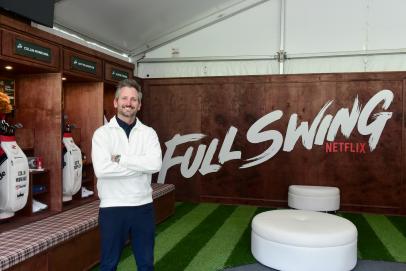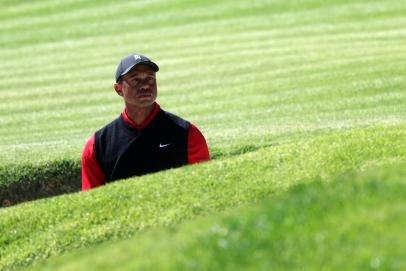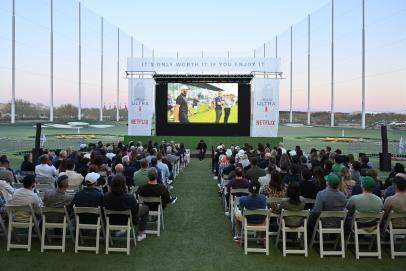Editor's Note: This article first appeared in Fire Pit Collective, a Golf Digest content partner.
I know the people behind the eight-part Netflix documentary golf series worked hard. I saw them in action, and inaction. Making a documentary eats time more ruthlessly than the DMV. It’s a difficult artform, making movies that tell the truth and reveal a deeper one. The guys who made Hoop Dreams spent three years just editing their film. In the end, it was spectacular. The kids in the doc became young men, looking all the while to change the course of their lives through basketball. Over time, the game almost becomes a business, but only almost. Good storytelling, no matter the medium, turns on the subtlest of things.
You can shoot all day and into the night until you get (if you’re lucky!) Michael Jordan, looking heavy, his eyes yellow, drink in hand, suddenly giving you a face, with no advance warning, that captures all of his disdain for Isiah Thomas.
But it’s a talkie, this famous documentary called The Last Dance, right? So you need audio too. You need spoken words. And not just any old words from a press conference. Words that will somehow give you more insight into the face you are watching. As for the director and the sound engineer and the boom-mic operator, that whole gang has one chance to get it right, if Jordan gives you anything worthwhile at all. Because you cannot say, “OK, Mike, but this time give us a beat after the word asshole, would you?”
It brings to mind Phil Mickelson, when he tells you about the 17 things going through his head before he plays a punch shot off pine needles, below a tree limb, over a pond and to a distant green that’s protected by a moat and impossible to hold. That’s part of the appeal of golf. Put a camera on any of us and every last shot becomes some sort of mini-documentary. Any round of golf is an epic tale.

Let’s go back to MJ and The Last Dance. You’re sitting there and he’s offering you, the viewer, a facial expression that you have never seen, not from him, but you’re going to use every bit of your life experience to read it. Nobody asked Jordan to produce this face, as a director does with an actor. A mood was created and it just showed up on him, washed over Airness like a wave.
Jordan’s words, the same. They’re not from a script. They’re from him. They come from deep within. And that combination, the one-two punch of words and pictures, advances our understanding of the subject—and ultimately some tiny part of the human condition. The gift of insight. We crave it in our lives.
And suddenly you’re looking at a screen and you’re covered in goosebumps. Or you’re reading a book, the same. Or listening to a podcast. Or watching Get Back.
I’ve got a feeling!
A feeling deep inside.
Oh, yeah.
OH, YEAH.
Yes, The Last Dance is the Michael Jordan story. When Jordan is your subject, you’re already on third base. (One career triple, as a Birmingham Baron, by the way.) But it could be anyone. I’ve staked my professional life on this: Any examined life is a window to the world. That statement means more to me at 62 than it did at 22, and it meant everything to me then.
It doesn’t even matter if you like basketball. You’re watching for the privilege of getting inside another person’s heart and mind and soul. In this example, the person is Michael Jordan. But it could be Joel Dahmen’s caddie. It could be Lydia Ko’s mother. It could be anyone. Earl Woods Jr.
In the first segment of the Netflix series, the subjects are Jordan Spieth and Justin Thomas and the episode is called “Frenemies.” It’s the only episode I watched and it did not make me want to watch others, although I have heard from reliable sources there are some good ones.
In “Frenemies,” the stakes are so low, and the problems of the two protagonists, as they were revealed to me, engendered no emotion. I did learn that Spieth tends to sit upright, with his seatbelt on, when flying in a private plane, while his lifelong friend and competitor, Thomas, looks as if he’s slouched on a sofa at home, playing on a Nintendo DS or something.
I wish the series well. I root for all serious storytellers.

Maybe someday, years or decades from now, other filmmakers will have another crack at this story.
Just doing some public note-taking here:
Both Thomas and Spieth were born in 1993. How does that biographical start, proximity in age, influence your connection to another person?
When did they feel closest as kids?
When did they feel most distant as kids?
How did each handle the agent recruitment process? Could they be open with one another, or was it the first time they had to keep things from each other?
In his deepest place, what was it like for Justin to watch Jordan win the Masters? The U.S. Open? The British Open? His blowup on 12 in the last round of 2016 Masters?
What was it like for Jordan Spieth, in the oasis of his lifelong home, Dallas, to be so far from the cool kids, as “JT and Tiger” became a thing, with Rickie Fowler riding shotgun?
How did it feel for Spieth to watch his buddy Thomas star on the 2019 Presidents Cup team, chest-bumping with Tiger and saving the day while Spieth, in a slump, neither made the team nor was chosen as a captain’s pick?

In “Frenemies,” we see and hear Spieth calling Thomas to discuss his role as the best man at JT’s wedding. It’s a neat moment.
It’s the tip of an iceberg.
We know who won the 2022 PGA Championship. We have seen the interiors of private planes.
What we want is an insight into the human condition.
Is that asking too much?
Michael Bamberger welcomes your comments at Bamberger@firepitcollective.com



